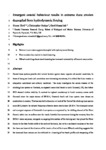Emergent coastal behaviour results in extreme dune erosion decoupled from hydrodynamic forcing
| dc.contributor.author | Hird, S | |
| dc.contributor.author | Stokes, C | |
| dc.contributor.author | Masselink, Gerd | |
| dc.date.accessioned | 2021-11-02T20:26:21Z | |
| dc.date.available | 2021-11-02T20:26:21Z | |
| dc.date.issued | 2021-12 | |
| dc.identifier.issn | 0025-3227 | |
| dc.identifier.issn | 1872-6151 | |
| dc.identifier.other | 106667 | |
| dc.identifier.uri | http://hdl.handle.net/10026.1/18204 | |
| dc.description.abstract |
Coastal dune systems provide vital natural barriers against storm impacts and coastal inundation. In times of rising sea levels and uncertainty over increasing storminess, it is critical that dune erosion is adequately understood and actively monitored. This study investigates the severe erosion of the climbing dune system at Crantock, an exposed macro-tidal beach in north Cornwall, UK, that before 2013 showed relative stability. In contrast to regional consistency in beach recovery across north Cornwall since the major storms of 2013/14, Crantock beach and dune system have shown an acceleration in erosion. This has resulted in dramatic cut-back of the front of the climbing dune system since 2016, despite the reduced frequency of severe storm events since 2013/14. The decoupled nature and emergent response of Crantock's dune system are explained by the shifting channel of the River Gannel, which has its outflow over the beach. Intertidal bar movement during the recovery from the 2013/14 storm sequence, alongside an ongoing deterioration of the training wall that pinned the River Gannel to the East Pentire cliffs to the north of the beach, has led to a southward avulsion of the river that has since lowered the elevation of the beach in front of the dunes. XBeach modelling suggests that the increased dune erosion can be attributed to a lowering of the beach profile and steepening of the dune face, indicating that the river avulsion has triggered a step-change in the dune equilibrium and the onset of dramatic erosional events. | |
| dc.format.extent | 106667-106667 | |
| dc.language | en | |
| dc.language.iso | en | |
| dc.publisher | Elsevier BV | |
| dc.subject | Dune erosion | |
| dc.subject | Beach lowering | |
| dc.subject | Emergent behaviour | |
| dc.subject | Storm response, storm recovery, XBeach | |
| dc.title | Emergent coastal behaviour results in extreme dune erosion decoupled from hydrodynamic forcing | |
| dc.type | journal-article | |
| dc.type | Journal Article | |
| plymouth.author-url | https://www.webofscience.com/api/gateway?GWVersion=2&SrcApp=PARTNER_APP&SrcAuth=LinksAMR&KeyUT=WOS:000710997500005&DestLinkType=FullRecord&DestApp=ALL_WOS&UsrCustomerID=11bb513d99f797142bcfeffcc58ea008 | |
| plymouth.volume | 442 | |
| plymouth.publication-status | Published | |
| plymouth.journal | Marine Geology | |
| dc.identifier.doi | 10.1016/j.margeo.2021.106667 | |
| plymouth.organisational-group | /Plymouth | |
| plymouth.organisational-group | /Plymouth/Faculty of Science and Engineering | |
| plymouth.organisational-group | /Plymouth/Faculty of Science and Engineering/School of Biological and Marine Sciences | |
| plymouth.organisational-group | /Plymouth/REF 2021 Researchers by UoA | |
| plymouth.organisational-group | /Plymouth/REF 2021 Researchers by UoA/UoA07 Earth Systems and Environmental Sciences | |
| plymouth.organisational-group | /Plymouth/Research Groups | |
| plymouth.organisational-group | /Plymouth/Research Groups/Marine Institute | |
| plymouth.organisational-group | /Plymouth/Users by role | |
| plymouth.organisational-group | /Plymouth/Users by role/Academics | |
| plymouth.organisational-group | /Plymouth/Users by role/Researchers in ResearchFish submission | |
| dcterms.dateAccepted | 2021-10-06 | |
| dc.rights.embargodate | 2022-10-9 | |
| dc.identifier.eissn | 1872-6151 | |
| dc.rights.embargoperiod | Not known | |
| rioxxterms.versionofrecord | 10.1016/j.margeo.2021.106667 | |
| rioxxterms.licenseref.uri | http://www.rioxx.net/licenses/all-rights-reserved | |
| rioxxterms.licenseref.startdate | 2021-12 | |
| rioxxterms.type | Journal Article/Review | |
| plymouth.funder | Physical and biological dynamic coastal processes and their role in coastal recovery (BLUE-coast)::NERC | |
| plymouth.funder | Physical and biological dynamic coastal processes and their role in coastal recovery (BLUE-coast)::NERC |


